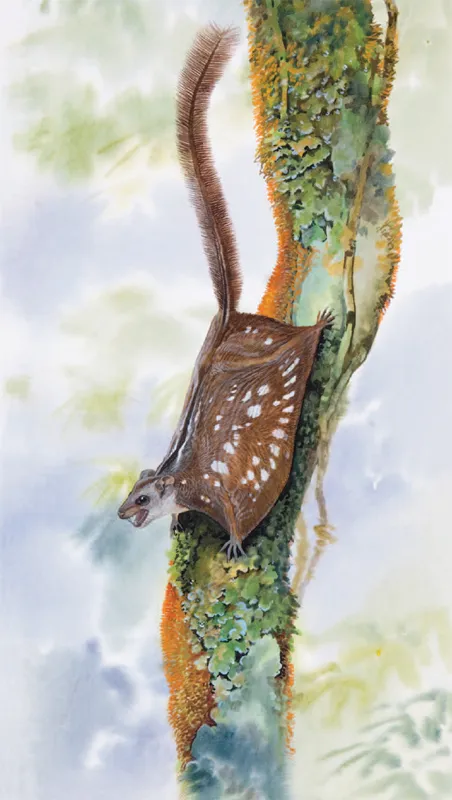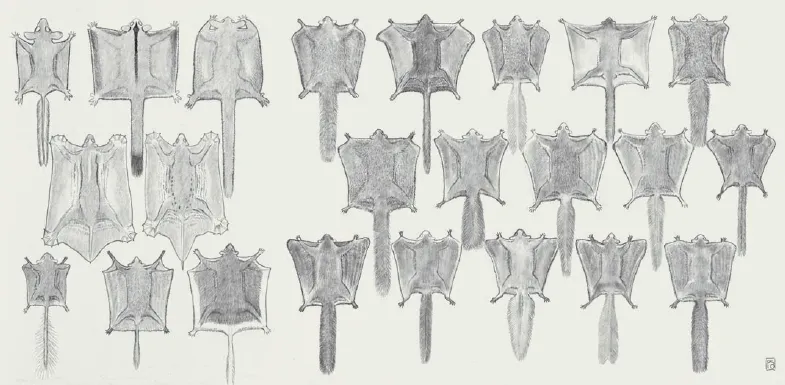![]()
Introduction
The world of gliding
The world’s gliding mammals are a diverse group of animals that have the unusual ability to glide from tree to tree with seemingly little effort. They do this by launching from the upper branches or trunk of a tree and spreading out their specially adapted gliding membranes, which stretch from the sides of their body between their fore and hind limbs. This allows them to glide silently through the night air for a considerable distance – some species are able to glide for more than 100 metres. During these glides they can twist and turn around obstacles to make a safe landing on a target tree without the need to come to the ground.
There are currently 65 recognised species of gliding mammals from six different families. There are three families of gliding marsupials that live in Australia, New Guinea and surrounding islands. These families include the Feathertail Glider (Family Acrobatidae), the gliding possums of the genus Petaurus (Family Petauridae), and the Greater Glider (Family Pseudocheiridae). However, by far the greatest diversity of gliding mammals occurs in the Order Rodentia, where they are represented by the flying squirrels belonging to the Family Sciuridae and the unrelated scaly-tailed flying squirrels of the Family Anomaluridae. The Sciuridae includes all the tree and ground squirrels with some 51 genera and 278 species in total. Of these, the flying squirrels comprise 15 genera and 49 species, and are found throughout Asia, Europe and North America. The family of scaly-tailed flying squirrels that live in central and western Africa has seven species, although one species does not glide. Gliding reaches its most spectacular and efficient in the two species of colugos, also known as flying lemurs, of the Order Dermoptera, which occur throughout South-East Asia.
Animals that glide between trees descend at an angle less than 45° to the horizontal, while those that parachute descend at an angle greater than 45°. Gliding is achieved by deflecting air flowing past a well-developed gliding membrane, or patagium, on each side of the body. These membranes convert the animal’s body into an effective airfoil, allowing it to travel the greatest possible horizontal distance with the minimum loss of height. The flying squirrels and scaly-tailed flying squirrels even have special cartilaginous spurs that extend either from the wrist, or elbow respectively, to help support their gliding membranes.
In addition to mammals and birds, gliding has evolved independently as a form of locomotion in several groups of arboreal and even aquatic vertebrates. These include flying fish of the Family Exocoetidae (from which we get the name Exocet missile), which have either two enlarged pectoral fins or even four enlarged fins (both pectoral and pelvic) to act as wings. These modifications allow them to make glides of over 60 metres above the water to escape from predators and potentially save energy.
The flying snakes of the genus Chrysopelea (and possibly the genus Dendrelaphis) of the Family Colubridae have developed a form of gliding by flattening and broadening their body like a ribbon through the use of hinged ventral scales, and by drawing in the belly so that it forms a concave surface when they leap out of trees.
Flying geckos of the genus Ptychozoon, fringed geckos of the genus Luperosaurus, and house geckos of the genus Cosymbotus (Family Gekkonidae) jump from tree to tree aided by webbed feet, flaps or folds of skin along the lateral body wall, and dorso-ventrally flattened tails that increase their horizontal surface area. Among the reptiles, however, the development of gliding reaches its pinnacle within the gliding lizards of the genus Draco (Family Agamidae). The ribs of these species are greatly elongated to create a large gliding surface, which folds against the sides of the body when not in use. When these lizards jump from a tree, they spread their ribs to stretch out the gliding membrane and can make glides of over 30 metres.
The Japanese Flying Squirrel weighs about 200 grams and is capable of gliding up to 100 metres.
Non-mammal vertebrates that have evolved the ability to glide include (from the top) the fying lizard (Draco), the fying gecko (Ptychozoon), the fying snake (Chrysopelea), the fying fsh (Exocoetidae) and the fying frog (Rhacophorus).
A variety species of frogs from three families are known to parachute or potentially glide. These include various species of flying frogs from the genus Rhacophorus and some of the whipping frogs of the genus Polypedates (Family Rhacophoridae) from South-East Asia. Several species of South American frogs of the Family Hylidae have extensive webbing including the Gliding Leaf Frog (Agalychnis spurrelli), Fringe-limbed Treefrog (Hyla miliaria) and Rabb’s Fringe-limbed Treefrog (Ecnomiohyla rabborum) and may also have the ability to glide. Various other frogs are known or thought to undertake controlled aerial descent including Hyperolius castaneus (Family Hyperoliidae) that occurs in tropical and subtropical forests of central Africa. The most developed frogs typically possess enlarged toes that have well developed webbing between them, with some species from the old world even having flaps of skin on the forelimbs and hind limbs to help trap air during descent. While the frogs with the most highly developed webbing may be able to truly glide, most species are more accurately described as parachuters. Nonetheless, the aerial control of these frogs is often so well developed that they can even make banked 180° turns.
Gliding adaptations
The two things (which may be related) that link every species of gliding mammal together are their nocturnal behaviour and their ability to glide. Despite the diversity of their origins, the different groups of gliding mammals show a remarkable degree of convergence in relation to their gliding adaptations and behaviour. But how do these animals undertake this extraordinary method of locomotion and how far can they glide?
The patagia, or gliding membranes, of mammals consists of skin with two layers bound together tightly by connective tissue with muscles and nerves between. There are four types of patagia: the propatagium, the digipatagium (or dactylopatagium), the plagiopatagium and the uropatagium.
The propatagium (or neck membrane) attaches on each side of the neck and along the anterior edge of the forelimbs of the glider. This patagium is most developed in the colugos and little developed or absent in other gliding mammals. The digipatagia are found only in the two species of colugos and consist of membranes between each of the five digits on both the front and the hind feet. The plagiopatagium (or flank membrane) is the primary gliding membrane and is found in all species of gliding mammals. It extends between the forelimbs and hind limbs, and is under good muscular control. When the glider is climbing, resting or sleeping the plagiopatagium remains mostly hidden in the fur of the glider’s flanks. The exception to this can be found in the colugos, whose movements are somewhat inhibited by their overly developed flank membranes. The uropatagium (or tail membrane) extends between the posterior surface of the hind legs and the tail. Only the larger gliding mammals which weigh more than approximately 1 kilogram have these tail membranes. The uropatagium can range from completely enclosing the tail in the colugos, to including the proximal third of the tail in the large flying squirrels, to being absent or rudimentary in the smaller gliding mammals. Despite the variation in patagium design, its surface area in relation to body mass remains remarkably consistent with body size, regardless of the taxonomic group considered.
In the gliding possums of the genus Petaurus, the plagiopatagium extends from the joint of the second and third bones in its fifth digit of the front paw to the metatarsal region in the ankle of the foot. A similar arrangement is found in the plagiopatagium of the flying squirrels, although they possess a thin cartilaginous spur (called a styliform cartilage) that extends from the pisiform bone in the wrist. The extended cartilage increases the size of the patagium, stiffens and supports it and helps unfold its lateral leading edge. When not gliding, the cartilage is folded back and held against the forearm.
The scaly-tailed flying squirrels, which are unrelated to other flying squirrels, have an unciform cartilage that originates from the olecranon process of the ulna in the forearm (near the elbow) and helps support the leading edge of the plagiopatagium, effectively increasing the size of the patagium. The development of a styliform or unciform cartilage has allowed these species to evolve a wider membrane, independent of the length of the bones of the forelimbs.
The Greater Glider is unique among marsupial gliders because it has a very small accessory cartilaginous spur that extends from the olecranon process near the elbow. Its olecranon is also greatly elongated, extending considerably past its elbow joint. The animal glides by holding its paws under its chin so that its elbows extend out to the sides at right angles to the rest of its body, thus helping to increase the surface area of the plagiopatagium.
The cartilaginous spurs of gliding mammals form ‘winglets’, rather like those of an aircraft, which redirect the forces of induced drag laterally at the wing-tip and allow greater fying efciency.
The outline of the patagia and tail shapes of all genera of gliding mammals. Top row: Acrobates pygmaeus, Petaurus breviceps, Petauroides volans, Aeretes melanopterus, Aeromys tephromelas, Belomys pearsoni, Biswamoyopterus biswasi, Euglaucomys fimbriatus. Middle row: Galeopterus variegatus, Cynocephalus volans, Eupetaurus sp., Glaucomys sabrinus, Hylopetes nigripes, Iomys horsfieldi, Petaurillus emiliae. Bottom row: Idiurus zenkeri, Anomalurops beecrofti, Anomalurus pelii, Petaurista leucogenys, Petinomys genibarbis, Pteromys volans, Pteromyscus pulverulentus, Trogopterus xanthipes.
From top to bottom: The bones of the forearm and the styliform cartilages of the Siberian Flying Squirrel, the unciform cartilage of Lord Derby’s Scaly-tailed Flying Squirrel, and the extended olecranon at the elbow of the marsupial Greater Glider.
The curved styliform cartilage of the flying squirrels, unciform cartilage of the scaly-tailed flying squirrels, and inflected wrists of the petaurids and colugos form ‘winglets’ at the end of their forelimbs. There is remarkable similarity in the front appearance of the different groups of mammals as each group has independently come to the same evolutionary conclusion that winglets provide a valuable aeronautic advantage. Many birds, as well as modern aircraft, use these winglets to increase the efficiency and stability of their flight.
So how do these winglets work? They increase the effective width of the patagium and play an important role in the control and manoeuvrability of the glider. The near-vertical bending back of the winglet reduces turbulence at the leading edge of the patagium by redirecting the airflow from a downward directional force to a more lateral direction. This reduces the ‘drag’ that is created at the front edge of the gliding membrane where the high pressure below the wing ‘leaks out’ around the tip and produces a downward force to the wing, enabling the animal to more efficiently maintain lift. The winglets alter the airflow at the wing-tips and increase the effectiveness of the wing without materially increasing the wingspan. They smooth the airflow across the upper wing near the tip and reduce the strength of wing-tip vortices, thus improving the lift-to-drag ratio. The changes in airflow also enhance the stability of the glider by reducing ‘rolling’ and ‘yawing’ about the centre of gravity in the glider. Aeronautical engineers have determined by experiment that aircraft winglets can reduce drag by approximately 20 per cent and increase the lift-to-drag ratio by approximately 9 per cent.
There are other adaptations in the marsupial gliders of the genera Petaurus and Petauroides that improve their gliding ability. The skeletons of the smaller gliding possums show a slight elongation of the bones of the limbs and virtually no elongation of the tail, compared to similarly sized non-gliding possums. The Greater Glider too has developed comparatively longer bones in both its forelimbs and hind limbs, compared to its similarly sized non-gliding relatives, the ringtail possums.
Unlike the other marsupial gliders, the Feathertail Glider shows no marked elongation of its vertebrae or limb bones, suggesting that in such small animals the presence of the patagium alone is sufficient to provide the necessary increase in surface area, although this is no doubt assisted by its feather-like tail.
The forelimbs and hind limbs of the flying squirrels are also relatively longer than those of similarly sized non-gliding arboreal squirrels. As a result of the elongation of the bones in gliding mammals, the shape of the patagium has a roughly square shape compared with non-gliders which, if a patagium were stretched over their li...






